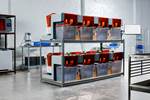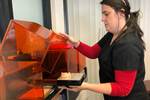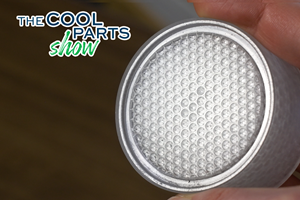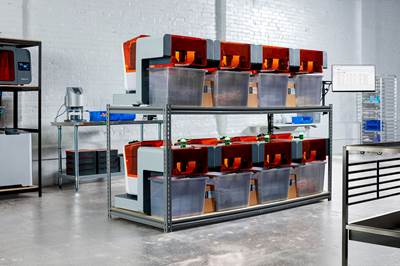Formlabs Part Removal Mechanism Enables Lights-Out Production
A build platform overcoming the need for manual part removal enables automated part handling, and therefore continuous production from one build cycle to the next.
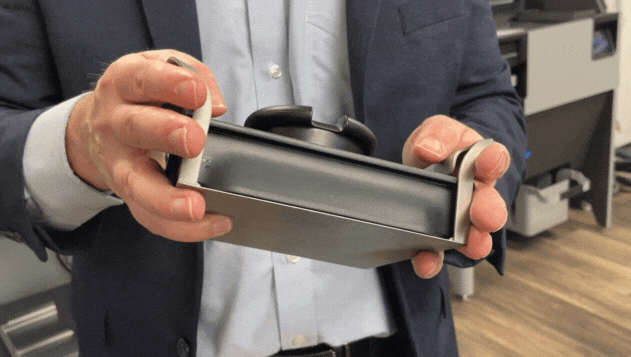
The Quick Release mechanism of the Build Platform 2. Mechanically distorting the build surface allows parts to break free and fall away, eliminating manual scraping for part removal.
The actuation mechanism seen in the simple video above is transformative to the ability to automate production of polymer parts on a desktop SLA machine. I came to appreciate this during a recent visit to Formlabs’ headquarters in Somerville, Massachusetts. The video demonstrates the company’s Build Platform 2 featuring (patented) Quick Release Technology. Previous build platforms for Formlabs SLA 3D printers required hand scraping — that is, a manual step — to remove completed parts from the build surface. The Quick Release action mechanically flexes the build surface, allowing parts to snap free and cleanly and effectively fall away.
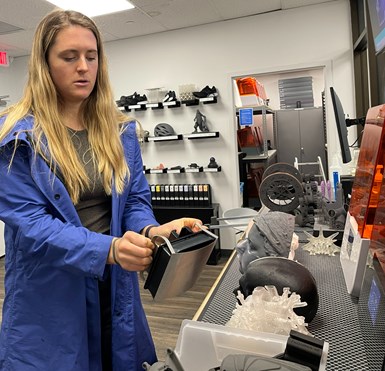
The Quick Release Technology is key to automation. Automatically removing parts is a requirement to unattended production, says Olivia Mattyasovszky.
Formlabs recently introduced its Automation Ecosystem for unattended production on SLA machines. My host during my visit, the company’s Olivia Mattyasovszky, pointed out to me that the Build Platform 2 is actually the enabler to this system.
“If you can’t automatically get parts off the build platform, you can’t do unattended production,” she says. “An operator might have to return every 45 minutes when a new build is complete.” Indeed, this very scenario — small SLA machines offering rapid 3D printing cycles, and therefore frequent need for part removal and job changeover — is a case where unattended operation in 3D printing is the most valuable.

The dental industry is a sector already using small SLA machines for production. Automation can make dental labs more efficient.
Formlabs has seen greater application for automation as small SLA machines find increasing application for mass customization, or production in which every individual part is tailored to the user. A novel application of this is Hasbro’s “Selfie Series” of action figures, in which SLA allows the action figure heads to be produced to individual specifications. However, Mattyasovszky points out that the much earlier and more widely applied mass-customization application is dental labs. A mouth guard is a 3D printed part made through SLA that is tailored to an individual patient, even though a dozen or more of them might be made in a single small SLA machine at the same time.

Here is the system for unattended production including the 3D printer and work-handling automation. The automation unit simply removes the build platform, actuates the Quick Release mechanism to let parts drop into a collector, and returns the platform to the machine for the next build. Parts accumulated in the collector can be gathered in the morning.
The Automation Ecosystem allows a production application of small SLA machines to run unattended, potentially producing custom mouth guards, for example, all through the night while no employees are present. The system retrofits to an existing Formlabs 3D printer, provided it uses the Build Platform 2. Thanks to this style of build surface, the actual part unloading automation is simple. The company’s unloading unit reaches into the 3D printer to remove the build platform. It actuates it through pressure similar to what is applied manually in the video above, and parts fall away into a container that can collect them until employees arrive in the morning.
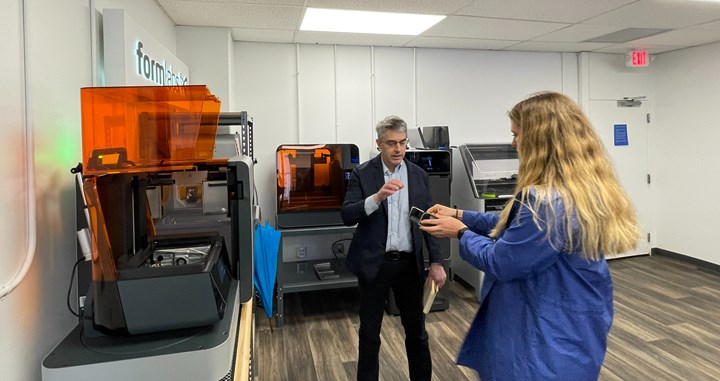
Formlabs’ small 3D printers are widely used for engineering prototyping. During a visit to the company's headquarters, Mattyasovszky and I discussed this use alongside the growing possibilities for automated production.
Related Content
8 Cool Parts From Formnext 2023: The Cool Parts Show #65
New additive manufacturing technologies on display at Formnext were in many cases producing notable end-use components. Here are some of the coolest parts we found at this year’s show.
Read MoreUltra-Complex 3D Printed Scaffolds Enable Cell Growth: The Cool Parts Show #70
Perhaps the ultimate surface-area challenge is in bioengineering: creating structures that can grow sufficient cells within a compact volume to be effective for leading-edge medical treatments. The Southwest Research Institute develops bioreactor scaffolds that could only be made using 3D printing.
Read MoreIce 3D Printing of Sacrificial Structures as Small as Blood Vessels
Using water for sacrificial tooling, Carnegie Mellon researchers have created a microscale method for 3D printing intricate structures small enough to create vasculature in artificial tissue. The biomedical research potentially has implications for other microscale and microfluidics applications.
Read MoreDurable, Waterproof 3D Printed Casts: The Cool Parts Show #58
Recovering from an injury with an ActivArmor cast means that patients can exercise, bathe and live life while they heal. We get a firsthand look at the solution in this episode of The Cool Parts Show.
Read MoreRead Next
Formlabs’ Automation Ecosystem Enables Automated 3D Printer Fleets
The Form Auto, Fleet Control software and High-Volume Resin System features enable users to increase 3D printing output, thereby reducing cost per part without adding operational complexity.
Read MoreDental Lab Brings 3D Printing into Digital Dentistry Workflow
With 3D scan technology and resin-based 3D printers, Spectrum Dental Printing is changing the way dental devices are made — and potentially, how dentistry happens.
Read MoreHasbro Uses Formlabs 3D Printing Technology to Create Custom Action Figures
Hasbro ushers in a new era of mass customization in consumer entertainment with its Selfie Series figures using 3D printing to manufacture personalized action figures at scale.
Read More

